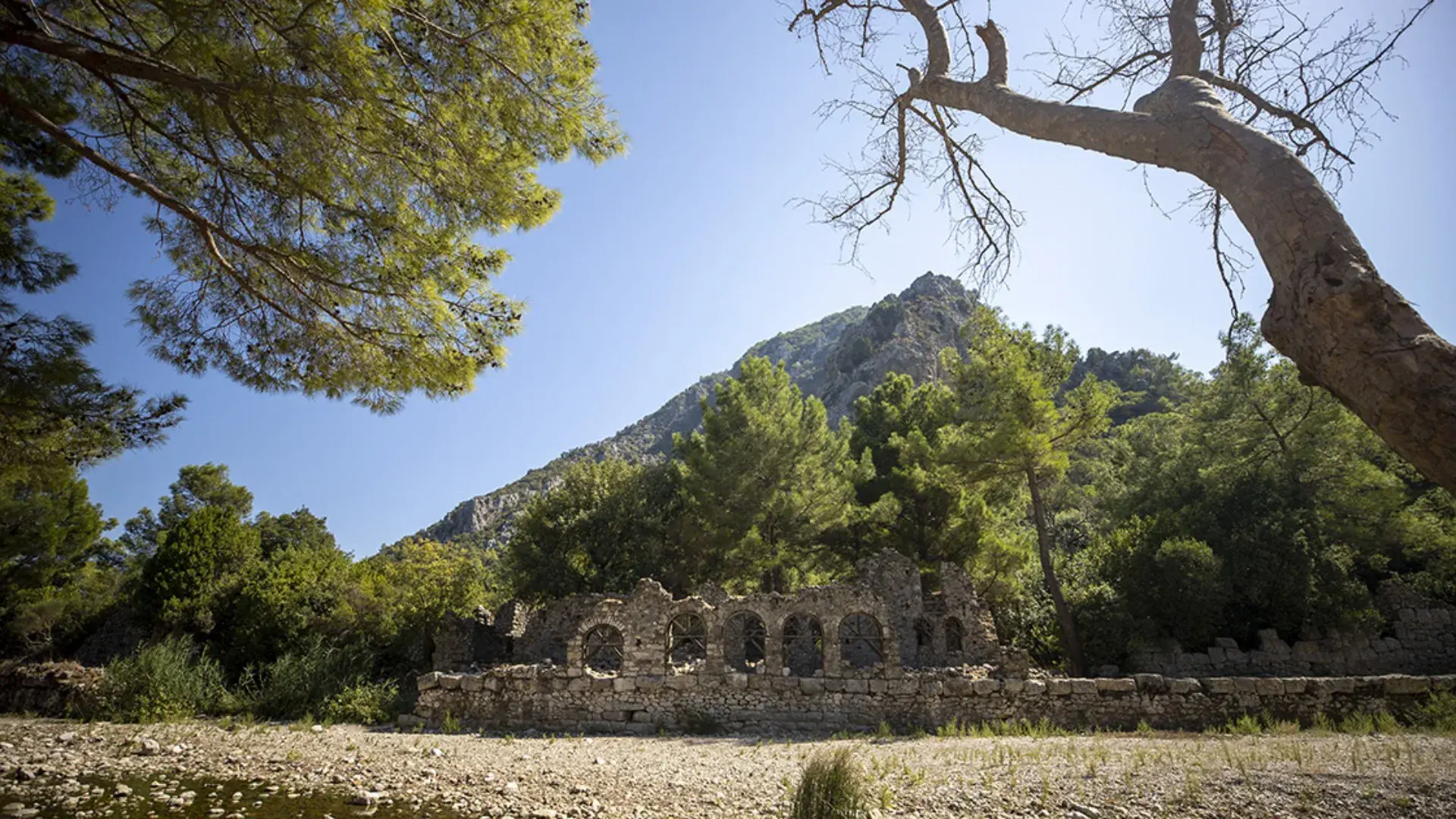Beydağları Coastal National Park
Description
The geological structure of the region, which includes the Young Mountains belt of the Western Taurus Mountains, is generally composed of limestone and serpentine rocks. In the mountainous terrain a few kilometers west of Olympos, the natural gas coming out of the cracks in the contact of limestone and serpentine formations and called the "Unquenchable Fire of Lycia" has been burning for centuries and has been passed into the mythos of Bellerophontos under the name of Chimaira (Burning Stone), giving mythological value to the region.
FAUNA
Mammals: Hedgehog, Fruit Bat, Mouse-Eared Bat, Porcupine, Squirrel, Arrowed Hedgehog, Rabbit, Jackal, Wolf, Fox, Rock Marten, Badger, Pig, Wild Goat are the mammal species found in the National Park and its immediate surroundings.
Birds: According to ornithological studies conducted in the National Park and its immediate surroundings to date, there are 85 bird species in the region. Of these species, 57 are native, 21 are migrants and 7 are summer migrants. Some of these species are Snake Eagle, Sparrowhawk, Hawk, Hawk, Bee-eagle, Kestrel, Little Kestrel, Wandering Falcon, Black Falcon, Partridge, Quail, Rock Pigeon and Wood Pigeon.
Reptiles There are 5 bivalves and 11 reptile species in the National Park and its immediate surroundings. Ulupınar Salamander, Kemer Salamander, Night Frog, Lowland Frog, Tree Frog, Striped Turtle, Tortoise, Sea Turtle, Taurus Lizard, Large Green Lizard, Black Snake, Slender Snake, Coin Snake, Bighead Snake, Semi-Aquatic Snake and Blind Snake.
Two new salamander species were discovered in the National Park. These species are Lyciaslamandra arikani (Ulupınar Salamander) and Lyciasalamandra yehudahi (Kemer Salamander). Both species are endemic.
FLORA
In the National Park, which has all the ecological conditions of the Mediterranean Region, the vegetation starts with pistachio pines on the seashore, and as it rises, red pine, black pine and cedar trees are seen above 1000 meters. The presence of nearly 1000 plant species and 21 endemic species within the borders of the National Park shows the diversity of the National Park in terms of species.
The red pine forests on Mount Tahtalı within the National Park are of international importance as they are one of the largest and best examples of lowland red pine forests in Turkey. At higher elevations, the red pine is replaced by cedar (Cedrus libani), larch (Pinus nigra ssp. pallasiana) and locally by tall juniper (Juniperus excelsa), scented juniper (Juniperus foetidissima), hornbeam-leaved slash (Ostrya carpinifolia) and thuja oak (Duercus infectoria) communities.
CULTURAL AND ARCHAEOLOGICAL VALUES
Located to the east of the region known as Lycia in ancient times, the National Park has been inhabited since prehistoric times. The finds in the Beldibi cave in the north of the coast prove this. The most important settlements of the National Park are the cities of Phaselis (Tekirova) and Olympos, which were founded as Rhodes Colony in the VII century BC.
In addition, the ruins of the ancient city of Idyros in Kemer district center show that the region has been an important maritime and trade center since the III century AD. Chimaera Ancient City, Adrasan Harbor and Gagai Ancient City are other historical settlements that should be seen.
CURRENT LAND USE
Within Beydağları Coastal National Park, there are 15 Day Use Areas, 3 Campgrounds, 3 Tour Routes, Hiking Trails, 3 Rest Points, 2 Scenic Viewpoints, Wildlife Observation Points, Rock Climbing Areas and 2 Paragliding Jumping Areas.
BEYDAĞLARI COASTAL NATIONAL PARK PLACES TO SEE
- Lycian Way
- Phaselis (Tekirova) Ancient City, Olympos Ancient City, Chimaera Ancient City, Gagai Ancient City,
- Cirali Yanartas
- Rat Island, Three Islands (3), Leek Island, Tuzla Islands (2), Sulu Island, Ball Island, Five Islands (Deveci Tasi), Shildanlar Islands, Fire Island (Ball Island)
- Adrasan Harbor
- Gelidonya Lighthouse
- Day Use Areas (Tünektepe, Topçam, Küçük Çaltıcak, Büyük Çaltıcak, Kargıcak-I, Kargıcak-II, Beldibi GB [Bahçecik-1, Bahçecik-2, Beldibi-1, Beldibi-2] Çifteçeşmeler, Kesmeboğazı-1, Kesmeboğazı-2, Kemer-1 (Küçük Burun), Kemer-2 (Ayışığı Bay), Üçgen, Alacasu Bay)
- Campsites (Göynük, Kındılçeşme and Göynük Canyon Çomaklar Mevkii)
- Tour Routes (Ancient Lycian Way, Adrasan-Sazak Bay, Cutting Strait - Sumakseniri Dams - Ancient Lycian Way)
- Hiking Trails (Göynük Canyon)
- Stops (Göynük Canyon, Yanartaş, Sazak Bay)
- Viewpoints (Cape Kuzu, Cape Fener)
- Wildlife Observation Points
- Rock Climbing Areas (Akyarlar and Olympos)
- Paragliding Jumping Areas (Tünektepe and Tahtalıdağı)
- Cable Car Line and Stations (Tünektepe and Tahtalıdağı)
- All Sea Sports,
- Observation of Rich Vegetation and Geological Structure,
- Tented Camp
- Excursions to Archaeological Sites,
- Nature Walks,
- Nature Sports (Paragliding, Rock Climbing, etc.),
- Picnic
- Photography
- Vacation accommodation (hotel, motel, bungalow, etc.) is available.
- TRANSPORT
-
Transportation within the National Park is provided by Antalya-Kemer-Kumluca highway. There are 3 tunnel passages between Antalya-Beldibi.
Short Description
The geological structure of the region, which includes the Young Mountains belt of the Western Taurus Mountains, is generally composed of limestone and serpentine rocks. In the mountainous terrain a few kilometers west of Olympos, the natural gas coming out of the cracks in the contact of limestone and serpentine formations and called the "Unquenchable Fire of Lycia" has been burning for centuries and has been passed into the mythos of Bellerophontos under the name of Chimaira (Burning Stone), giving mythological value to the region.







